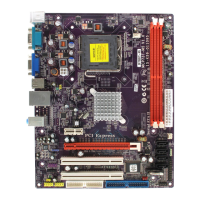
Do you have a question about the ECS GF7050VT-M5 and is the answer not in the manual?
| Number of memory slots | 2 |
|---|---|
| Maximum internal memory | 8 GB |
| Processor socket | LGA 775 (Socket T) |
| Processor manufacturer | Intel |
| Compatible processor series | Intel Core 2 Duo, Intel Core 2 Quad |
| CPU fan connector | Yes |
| Number of SATA connectors | 4 |
| Serial ports quantity | 1 |
| USB 2.0 ports quantity | USB 2.0 ports have a data transmission speed of 480 Mbps, and are backwards compatible with USB 1.1 ports. You can connect all kinds of peripheral devices to them. |
| Firewire (IEEE 1394) ports | 0 |
| Certification | ROHS |
| Power source type | ATX |
| Audio output channels | 6.1 channels |
| Motherboard form factor | micro ATX |
| BIOS type | AMI |
| BIOS memory size | 64 Mbit |
| Maximum graphics card memory | 256 MB |
| RAID levels | 0, 1 |
| Depth | 194 mm |
|---|---|
| Width | 244 mm |
Covers legal notices regarding the manual's content and usage rights, including disclaimers and copyright information.
Details FCC and Canadian regulations for digital device operation, including interference standards and compliance statements.
Provides information on the manual's structure, content organization, and guidance on how to navigate its sections.
Introduces the specific motherboard model, its intended market, and its primary design goals.
Details essential hardware specifications including processor support, chipset, memory, audio, and LAN capabilities.
Describes the motherboard's expansion slots (PCI, PCIe) and integrated input/output ports.
Illustrates the motherboard layout and labels key physical components and connectors for easy identification.
Outlines essential safety precautions for handling electronic components and guidelines for selecting a compatible computer case.
Provides step-by-step instructions for physically mounting the motherboard into a computer chassis.
Explains how to identify and configure motherboard jumpers for various system settings.
Guides on installing the CPU and memory modules, including precautions and procedures.
Details the function of expansion slots and the procedure for installing add-on cards.
Covers the installation of IDE, SATA hard drives, CD-ROM drives, and floppy diskette drives.
Explains how to connect front panel audio, USB headers, SPDIF, CD audio, and rear I/O ports.
Guides on connecting internal case components such as power switches, LEDs, speakers, and power supply connectors.
Explains how to access and navigate the BIOS Setup Utility, including key functions and standard configuration.
Covers configuration of date, time, IDE/SATA devices, and setting the boot device order.
Details advanced system settings, CPU features, chipset configurations, and peripheral options.
Configures onboard peripherals like IDE, SATA, Audio, LAN, USB, and system power management features.
Explains how to monitor system health (temperatures, voltages, fan speeds) and adjust frequency/voltage settings.
Covers setting supervisor/user passwords, loading default settings, and procedures for updating the BIOS.
Describes the contents of the support CD-ROM and guides on the automatic installation process for Windows XP/Vista.
Provides instructions for manual driver installation and references available utility software on the CD.
Guides on creating non-bootable and bootable RAID arrays using the BIOS setup utility.
Details the process of installing necessary NVIDIA RAID drivers during operating system installation.